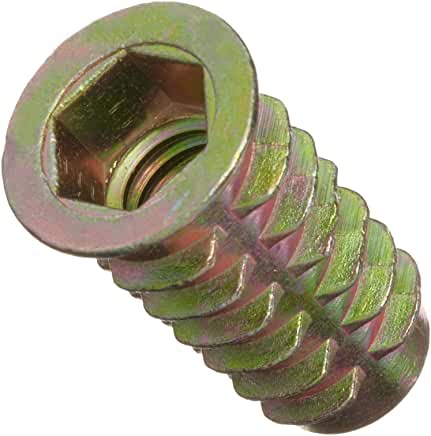Posts: 38
Threads: 0
Joined: Aug 2013
Location: Northern Virginia
If you have some kind of wood screw that isn't holding in the wood, I would look for a best-of-both-worlds solution. Get an insert nut like so --
and a bolt with the same threading as the nut. Drill the seat as needed to accommodate the insert nut, and epoxy that in. Then attach the leg and use Loctite to secure the bolt to the nut.
Dave
Posts: 116,093
Threads: 0
Joined: Jun 2002
Location: Sparkling Clearwater, Fl. Tampa Bay Area
(12-29-2020, 11:35 AM)merced Wrote: If you have some kind of wood screw that isn't holding in the wood, I would look for a best-of-both-worlds solution. Get an insert nut like so --
and a bolt with the same threading as the nut. Drill the seat as needed to accommodate the insert nut, and epoxy that in. Then attach the leg and use Loctite to secure the bolt to the nut.
Dave
......................
I think that because of the leverage against the wood and screw, it is compressing the wood, both threads and the area under the washer..There's lots of air in wood and you can see it being pulled out when you vacuum stabilize wood in a glass vessel like I made.
Often Tested. Always Faithful. Brothers Forever
Jack Edgar, Sgt. U.S. Marines, Korea, America's Forgotten War
Get off my lawn !

Posts: 923
Threads: 0
Joined: Nov 1999
Location: Williston ND
(12-26-2020, 09:46 AM)Gary G™ Wrote: Blue loctite might work for you.
I would not recommend lactate. It cures in the absence of oxygen and I doubt the metal to wood interface of a screw would be without oxygen. Plus loctite is thin and most of it would wick into the wood where it does no good. Mr Engel of EngelsCoachShop uses wood glue as a form of loctite in these situations such as here
https://youtu.be/1SFNGtwUGK4 He is very experienced in real world woodworking and if it works for him it works for me.
Proud maker of large quantities of sawdust......oh, and the occasional project!
Posts: 869
Threads: 0
Joined: Jun 2008
Do yourself a favor and torque stripe the screws on one stool. Assemble as usual, then paint a stripe across the head of the screw to the wood. Overtime, if the screw is backing out thru vibration, you will see that the painted line across the screw no longer lines up with the wood. If that happens, remove the screw and reinstall wet with epoxy.
But that will never happen. The reason the screws are getting loose has nothing to do with them rotating. The wood is drying and compressing and those two things will never stop. You are meant to tighten the screws as this occurs. Immobilizing the screws with epoxy (loctite won’t work) will ruin your furniture.
Posts: 887
Threads: 0
Joined: Sep 2009
Location: Carlisle, PA
I've had success in tapping coarse threaded bolt holes into hardwood and has them hold with no problems. After tapping, I ran some of the thin CA glue down into the tapped hole to stabilize the threads. After it set, I just ran the tap once more to remove any high spots.
I'm thinking you could do the same. Possibly start over by drilling out the holes and filling with a dowel. Then mark and pre-drill the holes for the screws. Run the screw in one time, back it out, and drip in some thin CA and let it set. Then tighten the screws back in again.
Posts: 24,145
Threads: 2
Joined: Sep 2003
Location: Missouri
We have a set of kitchen chairs that also loosen up.
I just get the allen wrench out every 6 months after I start hearing the squealing about loose chair legs.
Steve
Mo.
I miss the days of using my dinghy with a girlfriend too. Zack Butler-4/18/24
The Revos apparently are designed to clamp railroad ties and pull together horrifically prepared joints
WaterlooMark 02/9/2020







